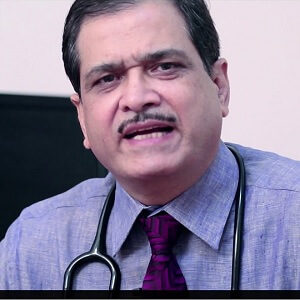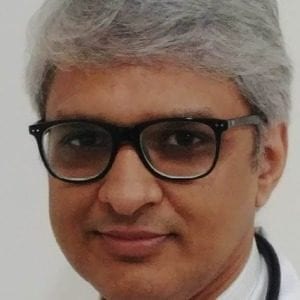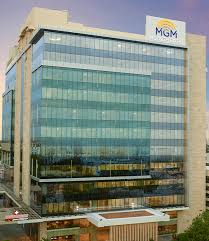Best Doctors in India for Thrombolysis Treatment
- Top Interventional Cardiologist | Apollo Hospital, New Delhi, India
- 26+ Years Experience
- Indraprastha Apollo Hospital, New Delhi
Profile Highlights:
- Dr. Rajeev Kumar Rajput is one of the best Cardiologists in India with nearly 23 years of experience. He is a clinical cardiologist engaged in diagnosing and treating cardiovascular diseases.
- Dr. Rajput is currently working as a senior consultant with Indraprastha Apollo Hospitals, New Delhi, and also offers patient care at the Heart & Gynae Clinic.
- Dr. Rajeev Kumar Rajput specializes in Angiography and Interventional Cardiology. The treatments provided involve Neonatal and Infant cardiac surgeries, Device Closure, and Valve replacement. He has expertise in Aortic Aneurysm Surgery, Vascular Surgery, Percutaneous Coronary Interventions, Endovascular Repair, Cardiac Catheterisation, Open Heart Surgery, and MV replacement.
- Dr. Rajput is credited with publishing several papers in noted medical journals.
- Cardiologist, Gurugram, India
- Over 20 years’ experience
Profile Highlights:
- Dr. Vivek Chaturvedi is a highly experienced and acclaimed cardiologist with over 20 years of experience.
- He has performed more than 2500 cardiac ablations, several of them for complex arrhythmias like atrial tachycardia, ventricular tachycardia, VPC, and atrial fibrillation using the latest technology like 3D Electroanatomic mapping.
- He has more than 50 publications in international journals & books.
- Interventional Cardiologist, Chennai, India
- Over 15 years’ experience
- Apollo Hospitals Greams Road
Profile Highlights:
- Dr. Sai Satish is a distinguished Senior Interventional Cardiologist affiliated with Apollo Hospitals in India, renowned for his pioneering contributions to the field of transcatheter valve therapies.
- His expertise extends internationally, as he also serves as a practicing interventional cardiologist and esteemed faculty member at the Gottsegen Institute of Cardiology in Budapest, Hungary, one of the world’s leading centers for TAVR (transcatheter aortic valve replacement) training.
- A trailblazer in the realm of minimally invasive cardiovascular procedures, Dr. Satish is celebrated for performing the highest number of percutaneous edge-to-edge mitral repairs (MitraClip implants) in the Indian subcontinent.
Best Hospitals in India for Thrombolysis Treatment
- City: New Delhi, India
Hospital Highlights:
- Over the last 33 years, the Fortis Escorts Heart Institute has set new standards in cardiac treatment with groundbreaking research. It is now known around the world as a centre of expertise for Cardiac Bypass Surgery, Interventional Cardiology, Non-invasive Cardiology, Paediatric Cardiology, and Paediatric Cardiac Surgery.
- The hospital has cutting-edge laboratories that perform a wide range of diagnostic tests in Nuclear Medicine, Radiology, Biochemistry, Haematology, Transfusion Medicine, and Microbiology.
- Fortis Escorts Heart Institute boasts a diverse group of bright and experienced doctors who are backed up by a team of highly qualified, experienced, and devoted support professionals as well as cutting-edge equipment such as the recently installed Dual CT Scan.
- Approximately 200 cardiac doctors and 1600 personnel currently collaborate to manage over 14,500 admissions and 7,200 emergency situations each year. The hospital now has a 310-bed infrastructure, as well as five cath labs and a slew of other world-class amenities.
- City: Faridabad
Hospital Highlights:
In the sprawling city of Faridabad, where healthcare needs are diverse and ever-evolving, one institution has consistently stood out as a beacon of excellence in the field of medicine—Marengo Asia Hospital. Established with a vision to provide world-class healthcare services to the community it serves, Marengo Asia Hospital has emerged as a trusted name synonymous with quality, compassion, and innovation in healthcare.
- City: New Delhi, India
Hospital Highlights:
- Equipped with 650 beds, BLK-Max Super Speciality Hospital is the largest stand-alone private sector hospital in Delhi.
- With over 1500 healthcare providers and 150 globally renowned super specialists, the hospital is one of Asia’s largest BMT Centres. The hospital is known for having some of the best cancer doctors in the country.
- The hospital is NABH and NABL accredited and was inaugurated by the first Prime Minister of India. Pt. Jawahar Lal Nehru.
- City: Chennai, India
Hospital Highlights:
- Located in Chennai, India, MGM Healthcare is a top multispecialty hospital that provides all medical services under one roof.
- Since its founding in 2019, MGM Healthcare has quickly become a leading national referral centre, creating several innovative flagship initiatives.
- MGM Healthcare combines next-generation medical and digital technologies to provide better patient results.
- With 12 centres of excellence, more than 400 inpatient beds, 100 intensive care unit beds, and 24/7 emergency care, MGM Healthcare leaves no chance in redefining the patient experience in Chennai.
- MGM Healthcare boasts 250+ expert doctors across 30+ departments, including Cardiology, Pulmonology, Neurology, Obstetrics & Gynaecology, and more.
- They house 12 specialized Centres of Excellence, including Neurosciences, Orthopaedics, and Multi-Organ Transplantation.
- Their team of doctors, nurses, and paramedics works together to give every patient individualized treatment.
- City: Noida, India
Hospital Highlights:
- Fortis Hospital, Noida, stands as one of the oldest and most trusted healthcare institutions in the region, setting a benchmark for comprehensive medical care.
- As the second mega hub hospital in the Fortis Healthcare Group, Fortis Hospital, Noida, upholds a legacy of trust among more than 1.2 million patients. By integrating top-tier professionals with cutting-edge technology, the hospital delivers superior treatment across various medical disciplines.
- Specializing in advanced Neurosciences, Orthopedics, Kidney and Liver Transplant Programmes, Fortis Hospital, Noida has successfully performed over 1,500 transplants, solidifying its reputation as a leader in specialized medical interventions.
Thrombolysis
Thrombolytic therapy commonly known as thrombolysis, is a treatment for dissolving dangerous clots in the blood vessels and for improving blood flow. It can also prevent damage to your tissues and organs.
This procedure is often used as an emergency treatment for dissolving blood clots that form in arteries that feed the heart and brain, which leads to heart attacks and ischemic strokes.
Purpose
When blood clots form in a blood vessel, it severely reduces or even cuts off blood flow to the parts of your body that are served by that blood vessel. This event can lead to serious damage to those particular parts of the body. If the clot forms in an artery supplying blood to your heart, for example, it can lead you to a heart attack. Similarly, a clot cutting off blood to your brain might lead to a stroke.
Thrombolysis is a treatment meant for dissolving blood clots which can cause serious and even life-threatening damage unless they are eliminated from the system. According to research, when this treatment is used for treating stroke, thrombolysis can help to prevent or reverse paralysis as well as any such problems that might result otherwise.
In the case of a heart attack, thrombolysis is an alternative to stenting, a procedure which involves inserting a spring-like device into a blocked blood vessel. Stenting is generally the preferred treatment, as it both removes the clot as well as opens the blood vessel, which may have internal cholesterol deposits. Though thrombolysis removes only the clot, it has an advantage and it is that it can be administered in hospitals with fewer resources.
Thrombolysis is also used for dissolving blood clots forming in catheters or tubes put into people’s bodies for medical treatments, such as dialysis or chemotherapy.
Preparation
Thrombolysis is usually an emergency treatment; therefore, you may not always have time to prepare for it. If you are diagnosed with a condition that is treatable with thrombolysis, you will be transferred to an intensive care unit so that your heart and lung functions can be closely monitored.
If you will be undergoing catheter-directed thrombolysis, you might be asked to fast.
Procedure
Clot-busting agents are generally given in two ways: through a peripheral IV or through a thin tube termed as a catheter, which is navigated to the site of the clot.
First, the clot-busting drug will be administered. This is usually performed in an ICU while your healthcare team monitors your heart and lung functions. The drug circulates within your bloodstream until it reaches the clot. In most cases, the blood clot should dissolve within a day or two. The procedure is monitored closely by your healthcare team using special X-rays and ultrasound scans. These images can also help to determine if the vein wall is damaged or narrowed, making it prone to more clots in the future.
After the procedure
In most cases, the treatment should reverse or alleviate the symptoms. However, the treatment is not always a success, and it might not dissolve the blood clot. This might be the case if the initiation of the treatment was delayed. At other times, even if the clot has dissolved, the affected tissues can get damaged permanently, due to a prolonged restriction of the blood flow. In such cases, further treatment can be required for addressing the causes of the blood clot, as well as repairing any damaged tissues and organs.
Risks
Although thrombolysis can usually improve blood flow safely and effectively as well as relieve or eliminate any symptoms in most patients without the need for any more invasive surgery, it cannot be recommended for every person. It is not suitable for patients who regularly use blood-thinning medication, herbs or dietary supplements or for people with certain conditions associated with an increased risk of bleeding. Some of these conditions include:
- Severe high blood pressure
- Hemorrhagic stroke resulting from bleeding in the brain
- Active bleeding or severe blood loss
- Severe kidney disease
- Recent surgery
Patients who undergo this procedure have a very small risk of infection as well as a slight risk of an allergic reaction to the contrast dye which can be required for imaging.
Besides the risk of serious internal bleeding, there are few other risks, which include:
- Bruising or bleeding at the access site
- Migration of the blood clot to another part of the vascular system
- Damage to your blood vessel
- Kidney damage in patients having diabetes or other pre-existing kidney diseases
Intracranial bleeding is the most serious complication which is possible and it is potentially fatal. However, this complication is generally very rare.










